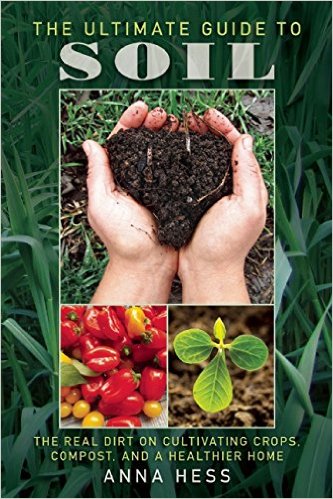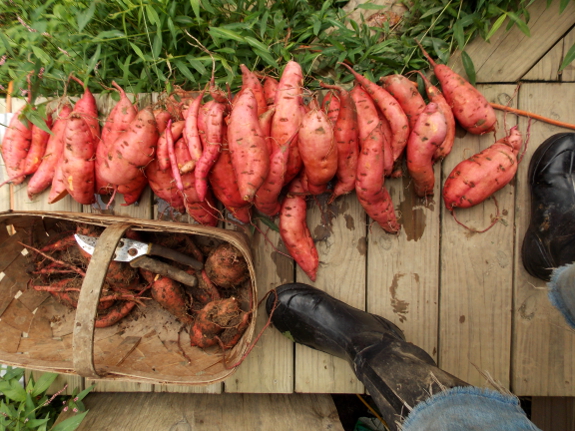
The Ultimate Guide to Soil
 I finished the first draft of The Ultimate Guide to Soil Friday...and also saw that the book is now up for preorder on Amazon! I'm thrilled by the cover, and I definitely feel like this is my best book yet.
I finished the first draft of The Ultimate Guide to Soil Friday...and also saw that the book is now up for preorder on Amazon! I'm thrilled by the cover, and I definitely feel like this is my best book yet.
In fact, I poured so much
of my soul into its pages that I had to write to my editor and see
whether she could fit an extra 15,000 words into the finished product.
The answer, in case you're curious, is yes! So I won't have to cut the
in-depth information on biochar, bokashi, black soldier flies, and many
other topics that don't begin with "b." Phew!
There's a lot of information in this book that never made it to the blog, so I'll tempt you with a teaser today:
Growing vegetables in poor soil
Weeds are probably the
largest deterrent to no-till gardening, but there are other issues
you'll have to contend with. Most notably, no-till techniques are slower
(if surer) than conventional soil preparation at creating
plant-friendly soil in poor ground. That means you may be faced with
subpar soil in certain parts of your garden during the first year or two
while you're waiting for the earthworms to do your job. Which begs the
question—which edibles can be successfully grown in extremely poor
ground?
Had Tolstoy been a gardener,
he would have warned that all happy soils are alike, but that each
unhappy soil is unhappy in its own way. So I can't give you a
one-size-fits-all list of vegetables that thrive in troubled ground.
That said, if you've already used the tests in the first quarter of this
book to figure out why your soil is ailing, you can likely select a
vegetable that will fare well even in those specific poor conditions.
Let's start with shallow
soil. This issue could be due to compaction in the subsoil, to a high
water table, or to a newly applied kill mulch with only a few inches of
compost on top. Although I don't usually recommend planting root crops
in soils of limited depth, a few roots are actually good choices in this
scenario. Specifically, onions, garlic, and radishes are reported to
keep their roots closer to the surface than most other vegetables, so
they're good growing choices in shallow soil. In contrast deep-rooters
like beets, carrots, Swiss chard, parsnips, and winter squash should
definitely be avoided in these scenarios.
How about low-nitrogen
conditions? This is one of the most common soil problems in new organic
gardens since biological sources of nitrogen often take time to release
nutrients into the soil. Nitrogen-fixing vegetables—primarily peas
and beans—are the obvious choice in this type of poor soil since
these vegetables literally create nitrogen out of thin air. Otherwise,
it's easier to tell you what not
to grow. Vegetables with above-average nitrogen demands include
potatoes, onions, cabbages, sweet corn, tomatoes, and celery. I
recommend steering clear of these heavy feeders if you don't have enough
nitrogen to go around and aren't able to pile on the compost.

Sweet potatoes thrive in certain types of ailing soil. In this photo, the tubers in the basket were harvested from the same square footage as the tubers stacked nearby, but the larger mess of taters came from poorer soil.
Another common issue involves
poor soil structure. For example, the high raised beds I build in
swampy parts of my homestead to pull vegetable roots out of wet soil
often end up with clayey subsoil on the surface and with partially
decomposing sod in the center. Although these beds mellow into rich
growing ground eventually, the first year or two are rough with heavy soil that
hinders seedling germination and root growth. Two crops that have
thrived for me in this type of troubled soil are sweet potatoes and
sunflowers. In contrast, carrots and butternut squash did so poorly in
this type of ground that I might as well have skipped planting entirely.
Medium-producers include large-seeded vegetables like beans and corn
that can handle heavier soil as long as I increase compost applications
for the latter.
Improper pH is another issue
that often takes a few years resolve. Luckily, it's relatively easy to
select vegetables that do well in excessively acidic or excessively
alkaline soil. Carrots, cucumbers, eggplants, green beans, parsnips,
peppers, potatoes, sweet corn, tomatoes, watermelon, and winter squash
can handle sour soil with a pH as low as 5.5. In contrast, beets,
cabbages, cantaloupe, peas, pumpkins, spinach, sweet corn, and tomatoes
will grow in alkaline soil with a pH up to 7.5. Outside those ranges,
though, you'll be better off sticking to blueberries (acidic soil) or
certain ornamentals (alkaline soil).
All of these selections
aside, you'll get even better results if you spend a year or two growing
cover crops in that troubled ground. These soil-building species will
not only add organic matter to your earth, they'll also often go a long
way toward fixing the underlying issues that are keeping vegetables from
thriving in the first place. For example, soybeans are a great cover
crop for very low-nitrogen soil, oats thrive in waterlogged ground, and
oilseed radishes are top-notch at both breaking up hardpan and making
phosphorus more available near the soil surface. Be sure to check out the full book if
you'd like to learn more about integrating these soil-improving crops
into your no-till garden.
Are you sold? You can pre-order the paperback now
and it will show up in your mailbox as soon as Amazon gets the first
box of books in. And their preorder price guarantee means you'll
actually pay less than the price listed if there are any sale periods
between now and launch day. So snag a copy now! I don't think you'll
regret it.
Want more in-depth information? Browse through our books.
Or explore more posts by date or by subject.
About us: Anna Hess and Mark Hamilton spent over a decade living self-sufficiently in the mountains of Virginia before moving north to start over from scratch in the foothills of Ohio. They've experimented with permaculture, no-till gardening, trailersteading, home-based microbusinesses and much more, writing about their adventures in both blogs and books.
Want to be notified when new comments are posted on this page? Click on the RSS button after you add a comment to subscribe to the comment feed, or simply check the box beside "email replies to me" while writing your comment.
- Remove comment
 Thanks so much for ordering even though you have to wait eight months!
Thanks so much for ordering even though you have to wait eight months!
- Remove comment
